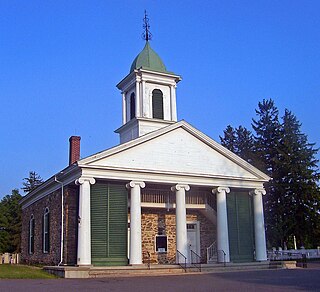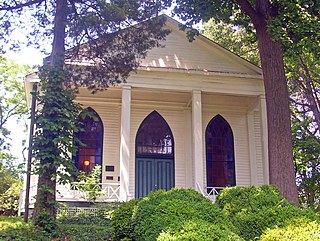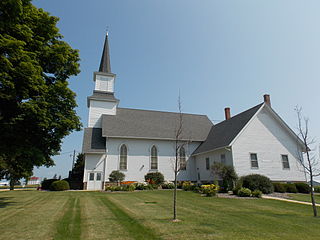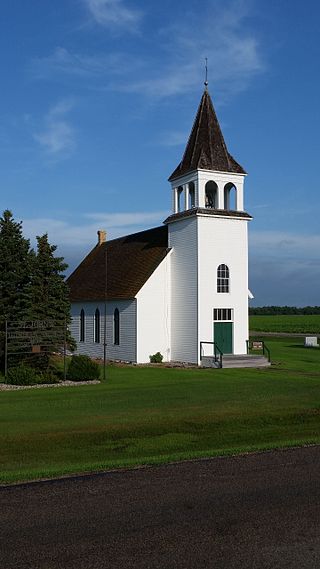
The Evangelical-Lutheran Church in Denmark or National Church, sometimes called the Church of Denmark, is the established, state-supported church in Denmark. The supreme secular authority of the church is composed of the reigning monarch and Denmark's Parliament, the Folketing. As of 1 January 2022, 73.2% of the population of Denmark are members, though membership is voluntary.

The American Lutheran Church (ALC) was a Christian Protestant denomination in the United States and Canada that existed from 1960 to 1987. Its headquarters were in Minneapolis, Minnesota. Upon its formation in 1960, The ALC designated Augsburg Publishing House, also located in Minneapolis, as the church publisher. The Lutheran Standard was the official magazine of The ALC.
The Lutheran School of Theology at Chicago (LSTC) is a seminary of the Evangelical Lutheran Church in America in Chicago, Illinois. LSTC is a member of the Association of Chicago Theological Schools (ACTS), a consortium of eleven area seminaries and theological schools. It shares the JKM Library and portions of its campus with McCormick Theological Seminary. LSTC is accredited by the Association of Theological Schools and regionally accredited by the Higher Learning Commission.

The Old Dutch Church of Sleepy Hollow (Dutch: Oude Nederlandse Kerk van Sleepy Hollow), listed on the National Register of Historic Places as Dutch Reformed Church (Sleepy Hollow), is a 17th-century stone church located on Albany Post Road (U.S. Route 9) in Sleepy Hollow, New York, United States. It and its three-acre (1.2 ha) churchyard feature prominently in Washington Irving's 1820 short story "The Legend of Sleepy Hollow". The churchyard is often confused with the contiguous but separate Sleepy Hollow Cemetery.

The Reformed Church of Shawangunk is located along Hoagerburgh Road in the Bruynswick section of the Town of Shawangunk, Ulster County, New York, United States. Perched above the Shawangunk Kill, it enjoys a splendid view of the nearby Shawangunk Ridge. Built between 1752–55, it is the oldest building in continuous use among American congregations of the Dutch Reformed Church.

The Bethesda Meeting House is a historic Presbyterian church complex in Bethesda, Montgomery County, Maryland, US. Its name became the namesake of the entire surrounding community in the 1870s. It sits on Maryland Route 355 just inside the Capital Beltway. It has been listed on the National Register of Historic Places since 1977.

Zion Evangelical Lutheran Church is a Neogothic Revival-styled church built in 1910 in Hartland, Wisconsin to serve its German-speaking Lutheran congregation. It was listed on the National Register of Historic Places in 1986.

St. Paul's (Zion's) Evangelical Lutheran Church is the official name of what is usually referred to as St. Paul's Lutheran Church in Red Hook, New York, United States. Its six buildings and cemetery are on a 15-acre (6.1 ha) lot on South Broadway just south of the village center. The current church is the third building on a spot that has been home to what was originally a Reformed congregation since 1796.

Old East Paint Creek Lutheran Church is located north of Waterville, Iowa, United States. The church building was listed on the National Register of Historic Places in 1983.

St. Peters United Evangelical Lutheran Church is a former Lutheran Church located in rural Clayton County, Iowa, United States. The church was a part of a village by the name of Ceres. The church building was listed on the National Register of Historic Places in 1976. The property is also known as the Pioneer Rock Church.

The Painesville Chapel is a historic meeting hall built in 1852 by German immigrant Freethinkers in Franklin, Milwaukee County, Wisconsin. It was added to the National Register of Historic Places in 1977.

Our Savior's Kvindherred Lutheran Church is an Evangelical Lutheran Church in America congregation located near the town of Calamus in rural Clinton County, Iowa, United States. The church and former school buildings as well as the church cemetery were listed as an historic district on the National Register of Historic Places in 2000.

St. John's Lutheran Church of Richland County, was built in 1883 by the faith community originally known as the South Wild Rice Lutheran Congregation, whose constitution was adopted on December 27, 1872. In 1882 the name of the faith community was changed to St. John's as construction of the building began. This wood-frame church still stands on its original "single course, dry-laid, uncut fieldstone foundation," and is located east of the Wild Rice River in the Red River Valley near Galchutt, North Dakota.

Danebod is a historic district at the south edge of the railway town of Tyler in southwestern Minnesota. Founded in 1885 by Danish Evangelical Lutherans led by Rev. Hans Jørgen Pedersen (1851–1905), the district comprises a group of buildings dating back to 1888 from Minnesota's oldest Danish immigrant settlement. Danebod remains until this day a predominantly Danish Lutheran, close-knit religious community. An annual celebration named Æbleskiver Days, held on the fourth weekend of July, celebrates Danish heritage and culture and includes a parade that goes down the town's main street with floats that are made by the various Danebod neighborhoods.
Danish Lutheran Church is located in Alta, Iowa, United States. The first meeting of the Danish Lutheran church society was held on February 22, 1880, with 42 people as charter members. They built this Gothic Revival church building in 1887. It measures 24 by 36 feet, and cost a $1,000 to build. The Rev. Amos Johnson served as the congregation's first pastor. The church building was listed on the National Register of Historic Places in 2011.

St. John's Lutheran Church is located in rural Franklin County, Iowa, United States, west of the city of Hampton. The church property was listed as a historic district on the National Register of Historic Places as St. John's Danish Evangelical Lutheran Church in 2015. At the time of its nomination it contained ten resources, which included five contributing buildings, two contributing sites, one contributing structure, one contributing object, and one non-contributing structure.

Waterloo Ridge Lutheran Church is located northwest of the unincorporated community of Dorchester, Iowa, United States. It and the churchyard form a nationally recognized historic district that was listed on the National Register of Historic Places in 2015. At the time of its nomination, it consisted of three resources, which included one contributing building, one contributing site, and one contributing structure.

St. John's Lutheran Church, also known as Evangelical St. John's German Lutheran Church, was a complex of historic buildings located north of Kalona, Iowa, United States. This Lutheran congregation was organized in 1870 by German immigrants who settled in southern Johnson County in the 1860s. It began as a mission under the direction of the Rev. J. Hoerlin, Sr., and it was formally incorporated in 1875. The simple frame church building was completed that same year. It rested on a concrete block foundation, from 1917, and featured three round-arch windows on the side walls and a fanlight over the main entrance. When the Rev. H. Hertle came as the first resident pastor in 1878 a two-story frame parsonage was built next to the church. Behind the church and parsonage sat an outhouse and a catechetical room that was used for children's religious instruction. Services in English were begun in 1905 because the younger members no longer spoke German.

The Dansk Evangelical Lutheran Kirke is a Gothic Revival-styled Lutheran church built in 1910 by the Danish-speaking congregation in Hartland, Wisconsin, United States. It was listed on the National Register of Historic Places in 1988 and on the State Register of Historic Places the following year.

West Paint Creek Synod Evangelical Lutheran Church and Cemetery is a historic building and site located northwest of Waterville, Iowa, United States. The church building and its adjacent cemetery were listed together on the National Register of Historic Places in 2019.




















